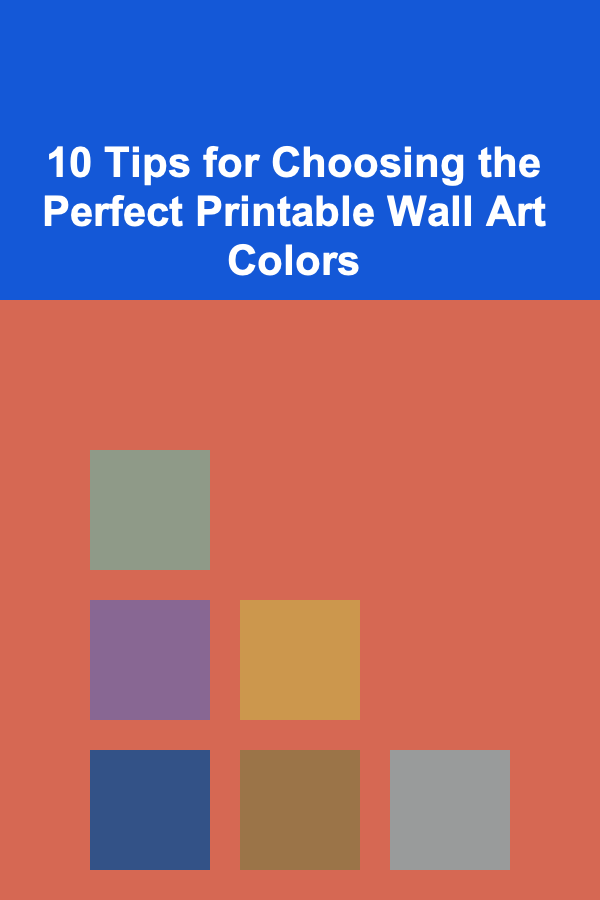
10 Tips for Choosing the Perfect Printable Wall Art Colors
ebook include PDF & Audio bundle (Micro Guide)
$12.99$6.99
Limited Time Offer! Order within the next:

When it comes to decorating your space, one of the most impactful elements is wall art. Whether you're revamping a room, enhancing a new home, or simply looking to add personality to your space, printable wall art is an excellent option. It's cost-effective, versatile, and customizable. However, while choosing wall art, one of the most critical decisions is picking the right color scheme. The colors you choose for your artwork can set the tone, complement the room's design, and create a harmonious atmosphere.
In this guide, we will explore 10 tips for selecting the perfect printable wall art colors that not only enhance your home decor but also create the mood you desire. From understanding color theory to considering room lighting, these tips will help you make informed choices that will bring your space to life.
Understand the Importance of Color Psychology
Color psychology plays a crucial role in how people perceive a space. Different colors evoke different emotions and can influence the ambiance of a room. Before choosing printable wall art, consider the psychological effects of various colors and how they align with the mood you want to create.
- Warm colors (red, orange, yellow) tend to evoke energy, warmth, and comfort. These colors are ideal for spaces where socializing and activity happen, such as living rooms or kitchens.
- Cool colors (blue, green, purple) promote calmness, relaxation, and focus. These colors work well in bedrooms, offices, or bathrooms.
- Neutral colors (black, white, gray, beige) are timeless and versatile. They can either serve as the base for other accent colors or create a minimalist, sophisticated feel.
Understanding the emotional impact of colors will help you select artwork that enhances the desired atmosphere in your space.
Match the Color Palette with Your Room's Existing Decor
When choosing colors for your printable wall art, it's essential to consider the existing color palette of the room. Your artwork should either complement or contrast with the room's current colors.
- If the room has a neutral color scheme, you can play with bold, vibrant artwork to create focal points and add contrast.
- In a room with bold, saturated walls or furniture, choose printable art with subdued or neutral tones to avoid overwhelming the space.
- For a harmonious look, you can opt for wall art that uses variations of the same color or analogous colors, which are next to each other on the color wheel (like blue and green or orange and yellow).
Matching your art's colors to the room's existing palette will create a cohesive look, making the space feel curated and intentional.
Consider the Room's Purpose
The function of the room significantly influences the choice of wall art colors. Different rooms in your home serve different purposes, and the colors of your wall art should reflect these functions.
- Living room: This is often the heart of the home, where guests are entertained. Choose wall art with vibrant colors or interesting contrasts to create energy and interest.
- Bedroom: The bedroom is a space for rest and relaxation. Choose calm, soothing tones like soft blues, greens, and grays to promote a restful atmosphere.
- Office: Wall art in a home office should encourage productivity. Focus on artwork with neutral or calm tones, such as blues, grays, and whites, or motivational quotes in bold, energizing colors.
- Bathroom: A smaller space like the bathroom can benefit from artwork with light and refreshing colors such as light blues, whites, and soft pastels.
By aligning your wall art's colors with the room's purpose, you can enhance the functionality of the space and create a more thoughtful design.
Use the 60-30-10 Rule for Balanced Color Scheme
One of the most widely used techniques in interior design is the 60-30-10 rule. This rule helps create balance and harmony in any room's color palette, and it's especially helpful when selecting colors for wall art.
- 60%: The dominant color, which covers the majority of the room (walls, large furniture, etc.).
- 30%: The secondary color, which is used for smaller furniture or accents (cushions, rugs, curtains, etc.).
- 10%: The accent color, used for smaller decor elements (artwork, vases, or other decorative objects).
When choosing printable wall art, ensure that the colors in the art follow the 60-30-10 principle. This allows you to incorporate eye-catching colors without overwhelming the room's overall design.
Consider Lighting and Natural Light
Lighting plays a critical role in how colors appear in a room. The type of lighting you have (warm, cool, or neutral) and the amount of natural light will affect how the colors in your wall art will look.
- Natural light: Natural light tends to make colors appear more vibrant and true to their hue. In well-lit rooms, you can experiment with a broader range of colors without worrying about them looking too dull or washed out.
- Warm light: If your room is lit with warm-toned lighting (yellow or orange hues), colors like red, orange, and yellow may appear more intense. On the other hand, cool colors like blue and green may appear softer.
- Cool light: Cool-toned lighting (blue or white light) can make warm colors look less vibrant, while cool colors may appear more pronounced. In these rooms, warm-toned artwork can create contrast and bring warmth to the space.
It's important to consider how your printable wall art will look in various lighting conditions. Test colors in the lighting environment before making a final decision.
Experiment with Bold or Subtle Contrasts
Contrasting colors can make your wall art stand out and grab attention. When done correctly, contrast adds visual interest and can create a dynamic atmosphere in the room. However, it's important to strike the right balance between boldness and subtlety.
- For a bold contrast, choose artwork with opposing colors on the color wheel, such as blue and orange or purple and yellow. These colors complement each other and create a striking visual impact.
- For a more subtle contrast, choose analogous colors (next to each other on the color wheel) or shades of the same color for a more serene and harmonious effect.
Contrasts can also be achieved through brightness, saturation, and lightness, not just color combinations. Experiment with different levels of contrast to find the right fit for your space.
Use Accents to Bring a Pop of Color
If you want to add a focal point or create a lively vibe without overpowering the room, use wall art to introduce a pop of color. This works particularly well in rooms that feature neutral or monochromatic color schemes.
- Choose artwork with bold, vibrant hues that contrast with the rest of the room, such as a bright red painting in a room with muted tones or a vivid yellow print in a cool-toned space.
- Alternatively, you can use wall art with metallic accents like gold, silver, or copper to add a touch of luxury and elegance without overwhelming the space.
Using accents to bring a pop of color will allow you to introduce bold choices without altering the entire room's color scheme.
Match Wall Art Color to Furniture or Upholstery
When choosing wall art colors, consider the color of the furniture or upholstery in the room. Wall art that complements your furniture can create a cohesive and unified look.
- If your furniture is solid-colored, you can use wall art to introduce a pattern or color that complements or contrasts with the furniture.
- If the furniture has intricate patterns or textures, opt for wall art with neutral or subdued colors to avoid competing with the furniture.
By carefully selecting printable wall art colors that align with the furniture, you can create a visually balanced and harmonious room.
Consider the Room's Size and Shape
The size and shape of the room also play a role in the colors you choose for your wall art. Large wall art pieces or prints with dark colors can make a room feel more intimate or cozy, while lighter-colored art can make a small room feel more open and airy.
- For smaller rooms, opt for wall art with lighter or pastel colors that won't overwhelm the space.
- In larger rooms, you can experiment with larger, bolder prints in deeper colors that create a sense of warmth and comfort.
Considering the size and shape of the room ensures that the artwork works with the space, rather than against it.
Trust Your Personal Taste and Style
Ultimately, the most important factor in choosing printable wall art colors is your personal taste and style. Choose colors that resonate with you, reflect your personality, and make you feel comfortable in your space.
- If you love vibrant, energetic colors, don't be afraid to choose wall art that expresses that passion.
- If you prefer a more subdued or minimalist aesthetic, opt for muted tones or black-and-white artwork.
Trusting your intuition and choosing colors that speak to you will help you create a space that feels uniquely yours.
Conclusion
Choosing the perfect printable wall art colors is an exciting yet challenging task that can significantly impact the ambiance of your home. By understanding color psychology, aligning the colors with your room's purpose, experimenting with contrasts, and considering lighting and personal style, you can create a visually cohesive and dynamic space. Remember, color is not only about aesthetics---it's about evoking emotions and creating a space that feels comfortable, engaging, and true to you.
Take the time to explore different color combinations and don't be afraid to experiment. With the right approach, your wall art will become a statement piece that enhances your living space and reflects your personal style.
Reading More From Our Other Websites
- [Home Space Saving 101] How to Find Creative Storage Solutions for Your Apartment
- [Home Cleaning 101] How to Make Spring Cleaning in Housekeeping a Family Activity
- [Organization Tip 101] How to Use Baskets and Bins for a Tidy Pantry
- [Organization Tip 101] How to Use Analytics Tools to Measure Productivity
- [Organization Tip 101] How to Set Up a Monthly Financial Check-In Routine
- [Survival Kit 101] Essential Items You Need: How to Build a Bug Out Bag for Any Emergency
- [Personal Investment 101] Earning Passive Income by Offering Deep Learning as a Service
- [Home Security 101] How to Get the Most Out of ADT Home Security: Tips for Effective Monitoring
- [Simple Life Tip 101] Best Simple Home Decor Ideas for a Calm & Peaceful Living Space
- [Home Storage Solution 101] How to Use Drawer Dividers for Neat and Efficient Storage

How to Inspect and Maintain Your Home's Plumbing Fixtures
Read More
How to Involve Kids in Learning About Jewelry Care and Organization
Read More
How To Master Creating Abstract Digital Art
Read More
Understanding the Intricate Relationship Between Climate and Health
Read More
10 Tips for Stocking a First Aid Kit for Pets
Read More
10 Common Retirement Plan Fees and How to Avoid Them
Read MoreOther Products

How to Inspect and Maintain Your Home's Plumbing Fixtures
Read More
How to Involve Kids in Learning About Jewelry Care and Organization
Read More
How To Master Creating Abstract Digital Art
Read More
Understanding the Intricate Relationship Between Climate and Health
Read More
10 Tips for Stocking a First Aid Kit for Pets
Read More